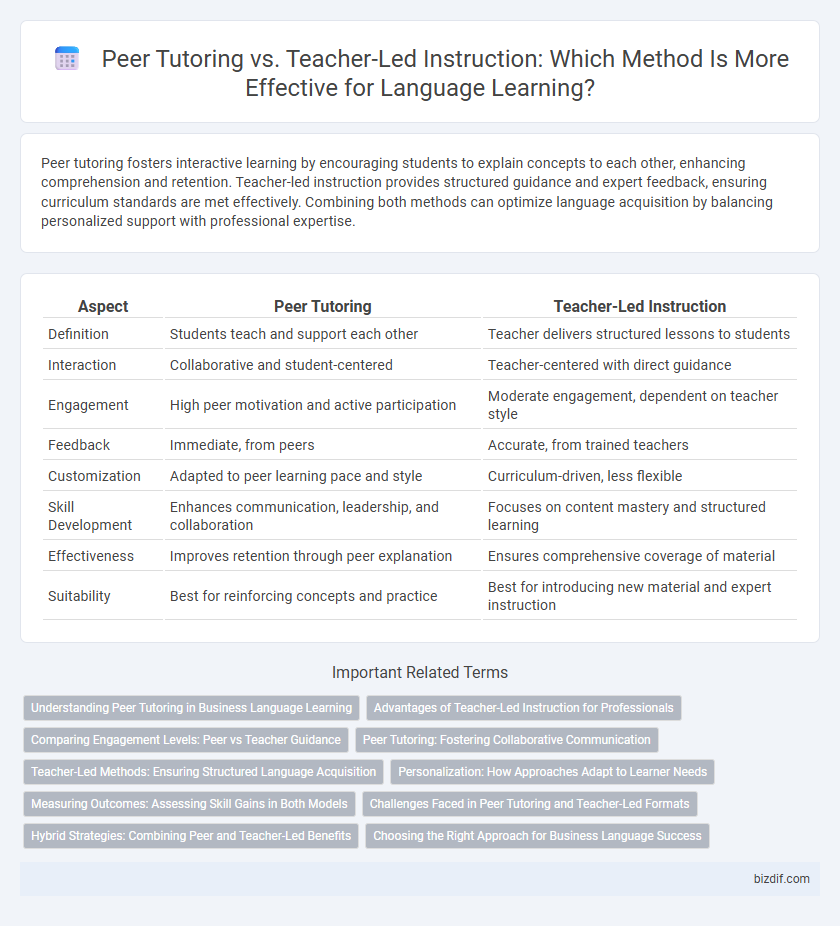Peer tutoring fosters interactive learning by encouraging students to explain concepts to each other, enhancing comprehension and retention. Teacher-led instruction provides structured guidance and expert feedback, ensuring curriculum standards are met effectively. Combining both methods can optimize language acquisition by balancing personalized support with professional expertise.
Table of Comparison
| Aspect | Peer Tutoring | Teacher-Led Instruction |
|---|---|---|
| Definition | Students teach and support each other | Teacher delivers structured lessons to students |
| Interaction | Collaborative and student-centered | Teacher-centered with direct guidance |
| Engagement | High peer motivation and active participation | Moderate engagement, dependent on teacher style |
| Feedback | Immediate, from peers | Accurate, from trained teachers |
| Customization | Adapted to peer learning pace and style | Curriculum-driven, less flexible |
| Skill Development | Enhances communication, leadership, and collaboration | Focuses on content mastery and structured learning |
| Effectiveness | Improves retention through peer explanation | Ensures comprehensive coverage of material |
| Suitability | Best for reinforcing concepts and practice | Best for introducing new material and expert instruction |
Understanding Peer Tutoring in Business Language Learning
Peer tutoring in business language learning promotes active engagement by pairing learners to practice and apply industry-specific terminology and communication skills. This collaborative method enhances personalized feedback and contextual understanding compared to traditional teacher-led instruction. Studies show peer tutoring increases retention rates by 30% through interactive role-playing and real-world business scenarios.
Advantages of Teacher-Led Instruction for Professionals
Teacher-led instruction provides professionals with structured, expert-guided learning that ensures accuracy and consistency in language acquisition. This approach facilitates immediate feedback and tailored correction of complex grammatical and technical language errors, supporting advanced proficiency development. Professionals benefit from a focused curriculum designed by experienced educators that aligns with industry-specific language requirements and professional standards.
Comparing Engagement Levels: Peer vs Teacher Guidance
Peer tutoring fosters higher student engagement by promoting active participation and collaborative problem-solving. Teacher-led instruction often relies on directive teaching, which can limit interactive dialogue and student involvement. Studies show peer-guided sessions increase motivation and deeper comprehension in language learning environments.
Peer Tutoring: Fostering Collaborative Communication
Peer tutoring enhances language instruction by promoting collaborative communication, where students actively engage in dialogue and practice language skills in authentic contexts. This interactive method facilitates deeper understanding and retention of vocabulary and grammar through peer feedback and shared problem-solving. Research shows that peer tutoring improves speaking fluency, listening comprehension, and confidence more effectively than traditional teacher-led instruction alone.
Teacher-Led Methods: Ensuring Structured Language Acquisition
Teacher-led instruction provides a structured framework for language acquisition by delivering targeted lessons designed to build foundational skills systematically. This method allows educators to implement curriculum standards effectively, monitor progress closely, and adjust teaching strategies based on students' performance data. Controlled classroom environments foster consistent practice of grammar, vocabulary, and pronunciation essential for mastering a new language.
Personalization: How Approaches Adapt to Learner Needs
Peer tutoring enhances personalization by allowing tutors to tailor explanations to the learner's specific language proficiency and learning pace, fostering a comfortable environment for practice and immediate feedback. Teacher-led instruction utilizes structured curricula and diagnostic assessments to adapt lesson plans and target individual student weaknesses systematically. Both methods address diverse learner needs, but peer tutoring offers dynamic, real-time adjustments while teacher-led instruction ensures comprehensive, guided personal development.
Measuring Outcomes: Assessing Skill Gains in Both Models
Peer tutoring often leads to significant improvements in language proficiency through increased interaction and personalized feedback, fostering collaborative learning environments. Teacher-led instruction provides structured assessments and targeted skill development, ensuring consistent progress across all language domains. Comparing outcomes requires evaluating fluency, comprehension, vocabulary retention, and speaking confidence to determine effectiveness in each model.
Challenges Faced in Peer Tutoring and Teacher-Led Formats
Peer tutoring in language instruction often faces challenges such as inconsistent feedback quality and varying proficiency levels between tutors and learners, which can hinder language acquisition. Teacher-led instruction struggles with limited individualized attention, reducing opportunities for personalized practice and authentic language use. Both formats must address classroom management issues and motivation to optimize learning outcomes effectively.
Hybrid Strategies: Combining Peer and Teacher-Led Benefits
Hybrid strategies in language instruction integrate peer tutoring and teacher-led instruction to maximize learner engagement and comprehension. This approach leverages the collaborative problem-solving and social interaction strengths of peer tutoring alongside the structured guidance and expertise provided by teachers. Research shows that combining these methods enhances language acquisition, retention, and critical thinking skills more effectively than using either strategy alone.
Choosing the Right Approach for Business Language Success
Peer tutoring fosters interactive communication and real-world business language application, enhancing learner engagement and retention. Teacher-led instruction provides structured content delivery and expert guidance, ensuring clarity in complex terminology and concepts. Selecting the right approach depends on learner needs, language proficiency levels, and specific business communication goals to maximize language acquisition effectiveness.
Peer Tutoring vs Teacher-Led Instruction Infographic

 bizdif.com
bizdif.com